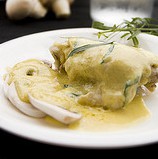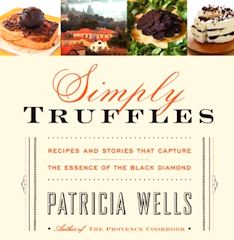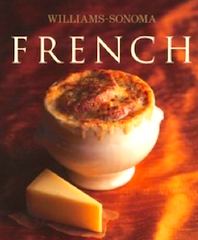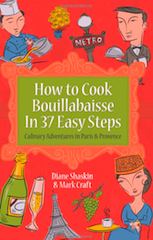Recipe: Blanquette de veau (veal stew)

- SUBSCRIBE
- ALREADY SUBSCRIBED?
BECOME A BONJOUR PARIS MEMBER
Gain full access to our collection of over 5,000 articles and bring the City of Light into your life. Just 60 USD per year.
Find out why you should become a member here.
Sign in
Fill in your credentials below.
 La Reynière calls it “virginal, naive and timid.” Sokolov says it’s a “white goddess” and “a milkmaid…pure and playful.” Jean-Louis Flandrin, who wrote a book on it, says, “it is a family dish and haute cuisine at the same time.” For me, this dish represents what French cuisine does best, for just as Perrault’s Cinderella transforms herself from a lowly housemaid to an elegant Princess, this dish takes common ingredients and techniques and turns them into something elegant and refined…and I can recreate it at home.
La Reynière calls it “virginal, naive and timid.” Sokolov says it’s a “white goddess” and “a milkmaid…pure and playful.” Jean-Louis Flandrin, who wrote a book on it, says, “it is a family dish and haute cuisine at the same time.” For me, this dish represents what French cuisine does best, for just as Perrault’s Cinderella transforms herself from a lowly housemaid to an elegant Princess, this dish takes common ingredients and techniques and turns them into something elegant and refined…and I can recreate it at home.
Blanquette de veau can be considered an institution of French cuisine. Indeed, noted food critic and author Raymond Sokolov included it in his book The Cook’s Canon: 101 Classic Recipes Everyone Should Know. The dish itself has a long history, and recipes for it were first noted in the 1739 edition of Dons de Comus in which the author makes reference to its long tradition. It also appeared on the menus of the very first Parisian restaurants. Flandrin, in his book on the subject, says that you can trace the history of French cuisine by studying the various recipes for this rather humble dish, which got its start with leftovers and then transformed itself into haute cuisine, appearing on the menus of starred restaurants.
The title of the dish gives you a hint as to what to expect—at least visually. Blanquette comes from the word blanc, which means white. Alan Davidson (Oxford Companion to Food) says that blanquette is an etymological cousin of blanket, which was originally a white cloth. In this stew the meat, onions, and mushrooms, if used, are all white and are ‘blanketed’ in a creamy white sauce. To start the stew, veal breast (now other cuts are used as well) along with various aromatic vegetables are poached in either water, veal or chicken stock. In most recipes labeled à l’ancienne—in the old style—the vegetables will be discarded and the veal and boiled pearl onions will be covered with a sauce made from the poaching liquid. Classically, the sauce is thickened with a liaison of egg yolks and cream. La Reynière claims that mushrooms should never be added, but I have found that most contemporary recipes use mushrooms and many even include the aromatic vegetables, such as carrots and celery. Blanquettes may also be made with chicken, lamb, turkey, and sweetbreads. Classic accompaniments are rice, boiled potatoes or noodles. . . .et voilà:
Blanquette de Veau à l’ancienne
INGREDIENTS:
- 1 lb. veal shoulder, cut into cubes
- 1 lb. breast of veal, cut into cubes
- about 3 cups of water
- Bouquet garni: 1 thyme sprig, 1/4 bay leaf tied inside 2 3-inch celery stalks
- 3 carrots, peeled & cut into thick sticks
- 12 baby onions, peeled
- 3 black peppercorns
- 1 teaspoon coarse salt
- 4 Tablespoons butter
- 3 Tablespoons flour
- 2 egg yolks
- 6 Tablespoons heavy cream
- 1 Tablespoon lemon juice
- pepper
- minced fresh parsley
PREPARATION:
1. Place meat in a large pot, cover with the water and bring to a boil over high heat. Skim off any foam that rises to the surface.
2. As soon as the water boils, add the bouquet garni, carrots, onions, peppercorns and salt. Cover the pot, lower heat and simmer for 1 hour.
3. Lift the meat and vegetables out of the pot with a slotted spoon, place in a serving dish and keep warm while finishing the sauce. Discard the bouquet garni.
4. Melt the butter in a saucepan and stir in the flour. Do not allow it to color.
5. When the roux is smooth, add the cooking liquid from the veal, little by little, whisking constantly.
6. Once the all the liquid has been incorporated, bring it to a boil and boil rapidly for 2-3 minutes to thicken the sauce. Remove the pot from the heat.
7. In a separate bowl, whisk together the yolks and the cream.
8. Whisking constantly, ladle some of the hot sauce mixture into the egg/cream mixture.
9. Whisk the lemon juice into the egg/cream mixture, then pour back into the hot sauce, continuing to whisk.
10. The sauce should be hot but not boiling. Season with some pepper and pour the sauce over the meat and vegetables.
To serve:
Sprinkle the stew with some minced parsley and serve immediately accompanied by buttered noodles or rice.
Wine Suggestions:
Reds: Anjou, Saumur Champigny, Macon or other light reds
Rosé: Bandol, Tavel
White: St-Véran
Debra Fioritto contributes delicious French recipes to BonjourParis—follow her at: @DebraFioritto on Twitter,Fabulous French Food, Julia’s Paris & Provence and Tour de Forks Uncommon Epicurean Adventures.
Would you like to propose a story? Submit an article or story idea.
Subscribe for free and never miss a story. Search our library with 7,200+ stories and 50 original stories published monthly. BonjourParis has been a leading online France travel and French lifestyle site since 1995.
![]() Thank you for using our direct link to Amazon.com, everytime you shop the world’s largest online retailer.
Thank you for using our direct link to Amazon.com, everytime you shop the world’s largest online retailer.
View our Top 100 Bestselling Amazon.com Items. (Wait for Amazon.com widget to load)
Featured selections:
Simply Truffles: Recipes and Stories That Capture the Essence of the Black Diamond by Patricia Wells. Nov. 8, 2011 release. Patricia Wells reveals the secrets behind the legendary truffle in this charming cookbook—featuring lush color photographs and 60 delectable recipes.
Williams-Sonoma Collection: French. Classic for every French kitchen.
How to Cook Bouillabaisse in 37 Easy Steps: Culinary Adventures in Paris and Provence by Diane Shaskin and Mark Craft. November 2011 release. Recipes and stories about authors’ culinary adventures: shopping the food markets from Paris to the wine villages of Provence and learning from the top chefs along the way.
Essential Pepin: More Than 700 All-Time Favorites from My Life in Food & bonus DVD w/ demonstrations by Jacques Pépin. October 2011 release. For the first time ever, legendary chef Jacques Pépin collects & updates the best recipes from his six-decade career. With a searchable DVD demonstrating every technique a cook will ever need. In his more than sixty years as a chef, Jacques Pépin has earned a reputation as a champion of simplicity. His recipes are classics. They find the shortest, surest route to flavor, avoiding complicated techniques….
Want more? View our recommended France-themed books & items. Most recent listings at last pages.
More in French food, French recipes, recipe






